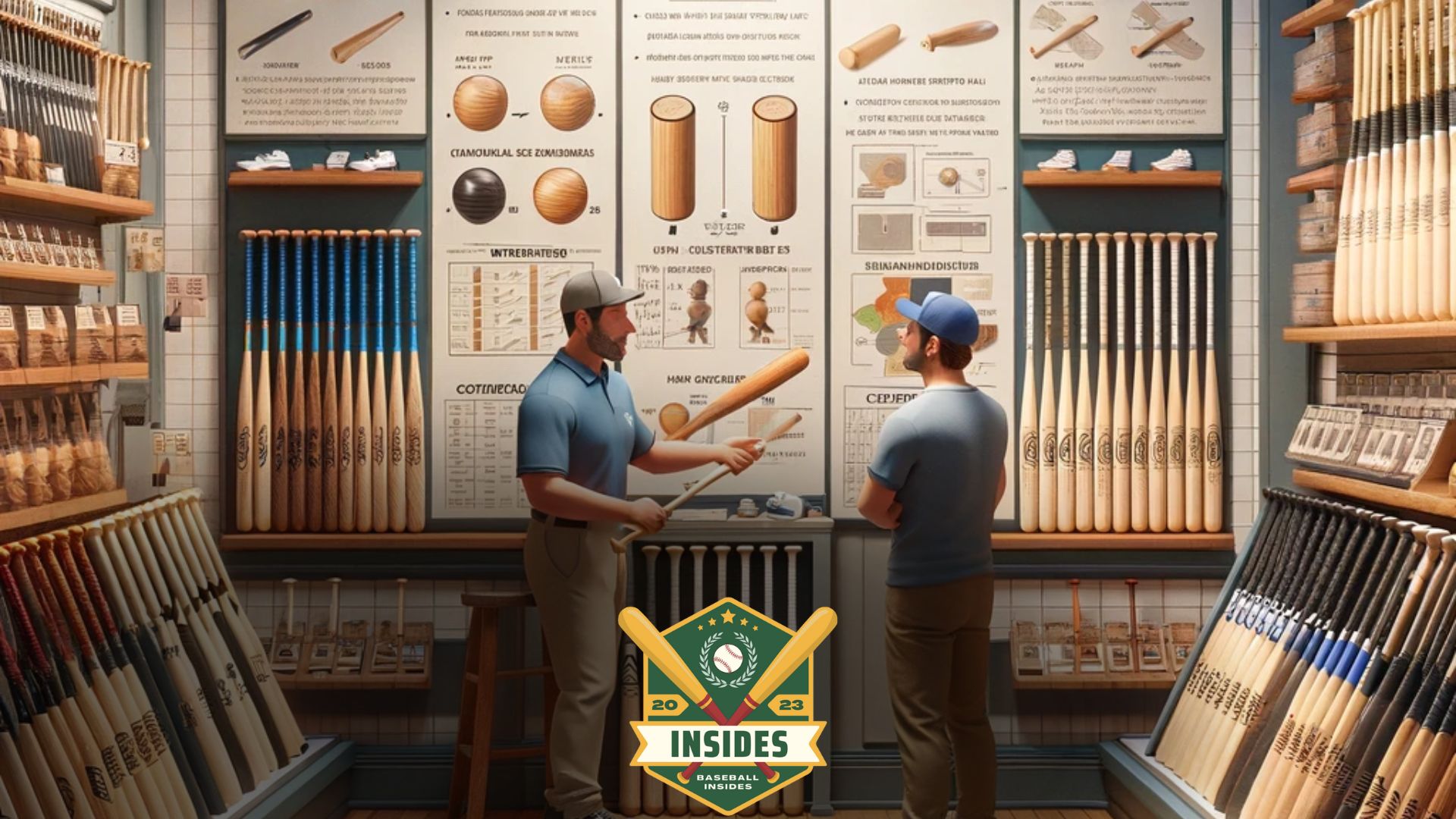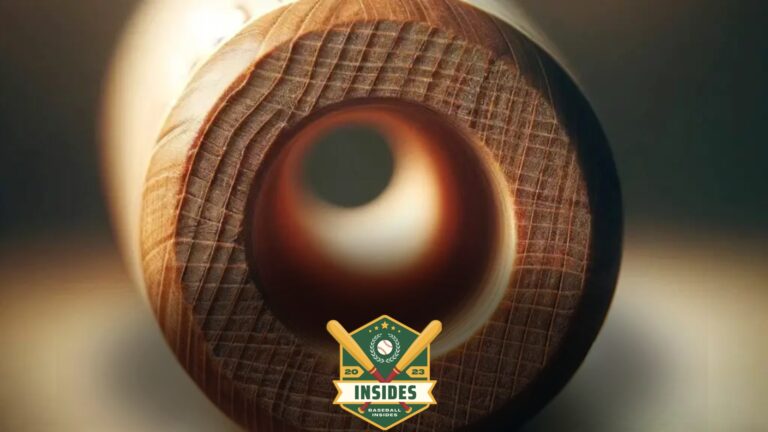
In this article:
Wood bats are crafted from natural timber, whereas wood composite bats blend wood with synthetic materials. The primary difference lies in the composition and performance characteristics.
Wood bats, known as lumber bats, have defined baseball’s classic look and feel for decades.
They resonate with the tradition of the sport, favored for their aesthetic and unique sound upon impact.
Handcrafted from types of wood like maple, ash, or hickory, these bats offer a one-of-a-kind batting experience.
On the swing, they provide a stiffer, more responsive feel. Conversely, wood composite bats represent modern advancement, engineered to reduce breakage and offer more durability.
Manufacturers combine wood fibers, plastic resins, and other composite materials to create a bat that stands up to repeated use while maintaining a wood-like performance.
This amalgamation enhances the bat’s lifespan and allows for consistent quality across bats.
Both choices have their advocates, with players selecting according to personal preference and league regulations.
Introduction to Baseball Bats
At the core of America’s pastime lies the iconic baseball bat, a tool that tells a rich story of the sport’s evolution.
Baseball bats have transformed over the years, catering to different levels of play and player preferences.
From young rookies to seasoned professionals, the bat remains a vital piece of equipment that can impact a game’s outcome.
The Popularity of Wood in the Game
Original baseball bats were carved from solid wood, a tradition stemming from the early days of baseball. When a player steps up to the plate with a wooden bat, they’re gripping a piece of history.
Wood bats offer a classic feel and sound, elements cherished by purists of the game. Types of wood like ash, maple, and hickory have their unique characteristics and advantages, giving players a variety of choices.
- Ash bats are light and flexible, allowing for a quicker swing.
- Maple bats are denser, providing more power.
- Hickory bats, less common today, are heavy and robust.
Emergence of Wood Composite Bats
The emergence of wood composite bats marks a significant milestone in baseball equipment innovation. Composite bats blend plastics, fiberglass, and wood to improve durability and performance.
These modern marvels consistently outlast their traditional counterparts and often come with the advantage of reduced weight and enhanced sweet spots.
Understanding the distinctions between wood and wood composite bats is crucial for players to make informed decisions about their gear.
The choice can influence hitting style, bat longevity, and, ultimately, on-field success.
Baseball enthusiasts continue to debate the merits of each, ensuring the conversation stays as lively as the sport itself.
| Wood Bat | Wood Composite Bat |
|---|---|
| Made from a single piece of wood | Constructed from a blend of materials |
| Traditional feel and sound | Enhanced durability and performance |
| Preferred in professional leagues | Popular in amateur and practice settings |
Material Composition
Material Composition lies at the heart of the debate between wood and wood composite bats. This fundamental aspect not only defines the performance and feel of the bat but also influences its durability and price.
Let’s delve into the unique qualities that distinguish these two types of bats, starting with their material makeup.
Natural Characteristics of Wood Bats
Traditional wood bats boast a natural origin, crafted from a single piece of timber.
Carved from trees like maple, ash, or birch, these bats inherit the wood’s inherent qualities:
- Unique grain patterns that influence flexibility and strength.
- Wood density affects the bat’s weight and hitting power.
- Variability in composition makes each bat one-of-a-kind.
Wood bats are highly esteemed for their direct link to the sport’s history, favored by purists who appreciate the classic feel and acoustic crack when the ball meets the bat.
Engineering Behind Wood Composite Bats
Stepping into the world of innovation, wood composite bats integrate modern engineering techniques.
These bats are a sophisticated blend of:
- Bonded layers of wood, often reinforced with plastic or resin.
- Uniform composition for balanced performance across different bats.
- Increased durability thanks to the engineering expertise.
Wood composite bats bring a consistent, long-lasting alternative to traditional wood bats.
Manufacturers fine-tune them for optimal performance, merging wood’s appeal with composite materials’ resilience.
Performance Factors
Exploring the ‘Performance Factors’ of bats digs into how they affect your game. The materials in wood and wood composite bats influence key aspects.
These include speed, control, and durability. Knowing these can help you choose the right bat.
Impact on Bat Speed and Control
Wood bats are classic. They have a varied weight distribution. This helps seasoned players improve their precision. Yet, they can be heavy. Younger players might find them harder to swing quickly.
Wood composite bats, on the other hand, offer a lighter option. They can help in swinging faster. This leads to potentially more powerful hits.
They also provide a consistent feel, improving control over where the ball goes.
Durability and Break-in Time
- Wood bats – made of natural materials:
- Can crack or break upon hard impact
- Don’t require break-in time
- Feel ready to use from the first swing
- Wood composite bats – a blend of wood and synthetic materials:
- More resistant to breakage
- Longer lifespan than traditional wood
- Need some break-in time to reach optimal performance
Their makeup determines how bats respond over time. Wood bats offer tradition and immediate use. But wood composite bats bring durability and a longer life.
Both can change your game. The right choice depends on your need for speed, control, and long-term use.
Appearance and Feel
The ‘Appearance and Feel’ of baseball bats can significantly influence a player’s choice and performance.
Both wood and wood composite bats bring unique characteristics to the game. Understanding these differences helps players select the best bat for their needs.
Aesthetic Differences
Wood bats boast a traditional, classic look that many purists admire. Natural wood grains shine through, making each bat one-of-a-kind.
These bats often have a clear or minimal finish, showcasing the wood’s beauty.
Wood composite bats, on the other hand, feature a more uniform appearance. They might be designed with a wide variety of colors and finishes.
Some replicate the wood grain effect, while others opt for modern, sleek designs that stand out.
Tactile Response During Play
When it comes to the feel of the bat during a game, wood and wood composite bats differ, too. Players report a distinct sensation with each contact with a wooden bat.
This feedback is raw and instant, resonating through the hands.
Wood composite bats often provide a smoother experience. They absorb the impact better, resulting in less sting on mishits.
This can offer a more forgiving feel, especially for new hitters adjusting to the game.
Both types of bats have their own unique balances and weight distributions. These factors contribute to their overall ‘feel’ and can affect swing speed and control.
Price Point and Value
Understanding the cost differences between wood and wood composite bats is key for buyers. Shoppers usually seek the best value for their investment.
This includes not only the initial price but also the life and durability of the bat.
Let’s dive into wood and wood composite bats’ investment cost and longevity details.
Investment Cost Comparison
Bats crafted from solid wood tend to be more affordable upfront. A typical wood bat can range from a modest price for a basic model to a premium for professional-level lumber.
Conversely, wood composite bats often carry a higher initial price tag. These bats combine wood fibers with synthetic materials. They may offer advantages that meet or exceed their increased cost.
Longevity and Replacement Rates
The long-term value of a bat greatly depends on its lifespan. Solid wood bats, while cheaper, might break or wear down faster, prompting more frequent replacements.
In contrast, wood composite bats typically demonstrate enhanced durability. This means they can last through more seasons of play before needing a replacement.
Table 1 showcases both bat types’ average lifespan and replacement rates to help guide your decision.
| Bat Type | Average Lifespan | Replacement Rate |
|---|---|---|
| Wood | 1-2 Years | Higher |
| Wood Composite | 2-4 Years | Lower |
Listed below are points to remember when comparing the values of both bat types:
- Initial investment in a wood bat is lower but may incur more frequent costs due to replacement.
- Wood composite bats are pricier initially, yet their extended lifespan means fewer purchases.
- Choosing the right bat involves assessing both short-term costs and long-term value.
Regulations and Usage
Understanding the difference between wood and wood composite bats goes beyond the material.
Each type of bat must adhere to specific regulations depending on the league and level of play.
This section details how league standards affect bat materials and what players should consider when choosing the right bat.
League Standards for Bat Materials
Different leagues maintain unique rules regarding bat composition. These regulations ensure fairness and safety on the field.
Bat standards can vary significantly – from youth leagues to professional levels.
- Little League: Emphasizes safety; typically allows both wood and composite.
- High School: Follows NFHS rules; non-wood bats must meet BBCOR standards.
- Collegiate: The NCAA requires bats to be BBCOR-certified.
- Professional: Major League Baseball exclusively uses solid wood bats.
BBCOR (Batted Ball Coefficient of Restitution) is a standard that governs the “pop” of non-wood bats.
It measures how a ball bounces off the bat. Composite bats must have BBCOR certification to perform similarly to wood bats.
Choosing the Right Ba for Different Levels of Play
Players should select bats that align with their league’s rules and their own skill levels. Performance and comfort also influence this choice.
| Level of Play | Wood Bat | Wood Composite Bat |
|---|---|---|
| Youth | Good for learning | Durable, great for practice |
| High School | Less common but viable | Must be BBCOR-certified |
| Collegiate | For specific wood bat leagues | BBCOR standard required |
| Professional | Only option allowed | Not permitted in games |
When selecting a bat, players should consider their league regulations, batting style, and what feels most comfortable.
Finding the right bat can help improve one’s game significantly.

Frequently Asked Questions
Can MLB use Wood Composite Bats?
MLB regulations permit players to use wood composite bats, provided they meet the official MLB standards. These bats combine wood and synthetic materials.
How Can You Tell If a Wood Bat is Composite?
Check the bat’s label; composite bats often have a “composite” mark. Tap the barrel; composite produces a distinct, dull sound compared to wood.
Do Composite Bats Lose Their Pop?
Yes, composite bats can lose their initial pop or performance level over time and with extensive use. Regularly rotating and properly maintaining the bat can extend its lifespan.
Can You Use Composite Wood Bats in Wood Bat Tournaments?
Composite wood bats are generally allowed in wood bat tournaments, but always check the specific tournament rules for approval.
What Defines a Wood Composite Bat?
A wood composite bat combines natural wood with synthetic materials to enhance durability and performance.
Conclusion
Understanding the distinctions between wood and wood composite bats is crucial for any player.
Wood bats offer a classic feel and sound, while composites provide durability and consistency. Choosing the right bat can greatly impact your experience at the plate.
Remember, your preference plays a pivotal role in this significant decision. Swing with confidence, knowing you’ve made an informed choice.






